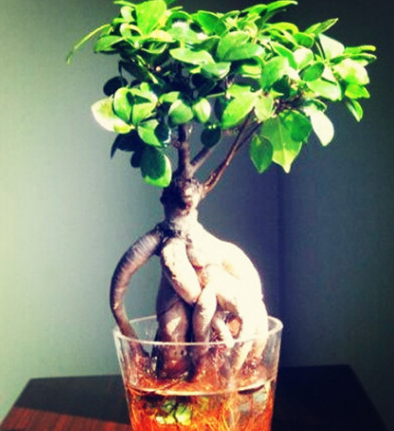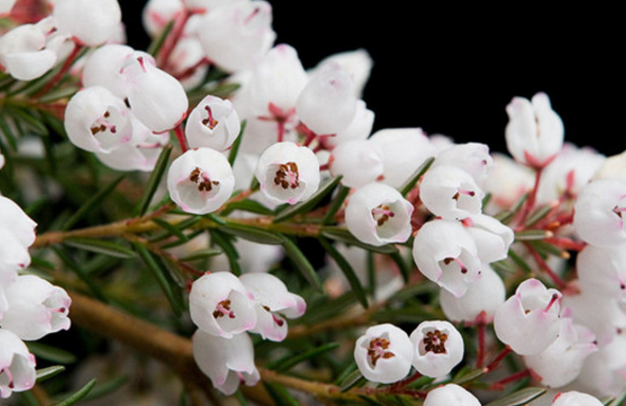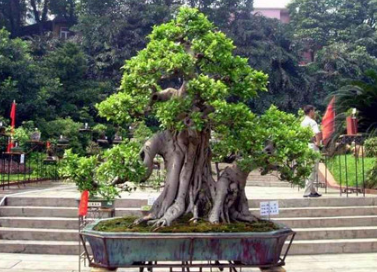What are the correct methods of hydroponic propagation of banyan trees
In subtropical areas such as South and Southwest China, banyan trees are often used to beautify the courtyard, and the aerial roots hanging from the canopy create a tropical rain forest atmosphere. Banyan trees can be large or small, and small stump bonsai can decorate the home.

How to correctly cultivate banyan trees in water
Preparation of banyan hydroponics
1. Prepare materials
First of all, go to the flower market to buy a small banyan tree, small leaf banyan can, when selecting to pay attention to the trunk to plant, branches evenly distributed,; green leaves beautiful, no dry tip.
Find a cylindrical glass basin with a diameter of about 10 cm and a height of 3 cm. Wash it and set it aside.
Find a large cola bottle and cut off the mouth of the bottle as a planting rack to keep it in a stable state.
2. Wash the plant
After buying home small leaf banyan, break the flowerpot, do not be reluctant to give up, so as to avoid root damage. Gently shake off the soil of the roots, wash the roots under clean water, and cut off the rotten parts to achieve a neat and clean banyan tree.
Of course, after washing, you can also soak in clean water for a period of time to thoroughly remove the soil from the roots.
3. Hydroponic environment
Control the temperature above 25 ℃ for about 2 weeks. During this period, put the hydroponic banyan tree in a cool and ventilated place and change water every day. When the original root grows a lot of white roots, this is the aquatic root, then your hydroponic culture is the first step.
After taking root, you don't need to change water every day. Always look at the water in the glass bottle to make sure that the water surface submerges 2/3 of the root system. In addition, you can use large cola bottled water, put it for half a day and use it, so that the tap water is full of gas and reduce the chlorine in it.
4. Hydroponic fertilization
Hydroponic banyan bonsai flowerpot is relatively shallow, to often add water, of course, nutrients can not be less. From April to October is the growing period of the banyan tree, about 30 grams of nitrogen, phosphorus and potassium compound fertilizer is put into the flowerpot every month, and the professional nutrient solution is also available, spraying potassium dihydrogen phosphate liquid fertilizer on the leaf surface every half a month.
Matters needing attention in hydroponics:
Hydroponic banyan tree, because of the lack of soil moisture, 3-5 years later, found that banyan tree growth is poor, can be re-soil culture, according to the growth of banyan tree, can be hydroponic culture again.
The form of banyan hydroponics:
1. Stone-attached water culture
Choose the stone with good water absorption, let the root of the banyan tree cling to the stone, and the root grows along the stone crevice. After 1-2 years, the root system and the stone will be closely combined, and the basin will be turned from April to May in the third year, and the water will be added to fertilize in time. This is how the stump on the stream stone is formed.
2. Flat root water culture
Choose a shorter banyan tree, or a small bonsai that has been formed, tile the roots in the shape of a claw, and plant them in a shallow basin. Keep cutting the roots during maintenance to make them grow smoothly.
What are the propagation methods of banyan trees?
1. Cutting propagation of banyan tree.
The cutting of the banyan tree is generally selected in spring. The 1-2-year-old branches are cut and the length is 5 cm to 15 cm. Each section contains 3 to 4 nodes. The lower leaf is removed, and only the upper leaf is retained. When the leaf is larger, it can be tied into a tube with a string.
The prepared branches were planted in the soil and planted in the soil. After cutting, the cuttings were covered with plastic film to keep moisture. The temperature was controlled at 25 ℃, 30 to 45 days to take root and sprout. After taking root, you can plant it in a pot.
2. Striping propagation of banyan tree
The family can also use the striping method for reproduction, burying part of the branches into the soil, compacting and watering, the operation is simple, generally about 30 days can take root. Select a two-year-old branch, peel the smooth part of the branch with a width of 1cm to 1.5cm, then wrap it in wet peat or moss, finally wrap it in a plastic film, tie it up and make some small holes in the film to grow roots.
3. Grafting propagation of banyan tree
Green branch grafting is commonly used in banyan grafting. Strong branches that are growing and not yet capped are selected, and more beautiful rootstocks are selected for grafting. Stop watering before grafting to reduce the bleeding in the process of grafting.
In grafting, the length of the scion is 2-3 cm, and the lower end is cut into a V-shaped shape. Cut into the top of the rootstock, cut down a knife edge of about 1.1 meters, and insert the scion. Then use plastic film to tightly pour water, put in a ventilated and bright place, uncover the film and breathe once a day, generally after about 45 days to survive and release.
What are the propagation methods of lotus palm by hydroponic culture
Lotus palms can also be called Guanyinlian and stone lotus flowers, which are very suitable for ornamental potted plants, so the hydroponic culture method of lotus palms? What are the propagation methods of lotus palm?
The method of hydroponic culture of lotus palm:
Rosette grass, stone lotus
Lotus palms like warm, dry and sunny environments. In winter, the temperature should be kept at about 10 ℃. Lotus palms can survive the winter safely. Lotus palm healthy growth needs sufficient light, slightly resistant to semi-shade, too shaded will lead to poor growth, resulting in loose plant shape, dark leaves, lack of vitality.
You can decorate the dining table, windowsill and children's bookshelves in the form of mini ornaments.
Fancy language: industrious, elegant and versatile
Hydroponic method
The main results are as follows: 1. The potted plants are directly removed from the pot to wash their roots and raised in water.
2. Pick a leaf or a stolon, insert it into the river sand, sprout new roots in about 15-20 days, and raise it in mini utensils after growing plantlets.
3. it is not moisture-tolerant, so the plant should be cultured in water, as long as the root system extends into the water.
4. Maintain it with clear water in hot summer and cold winter, and cultivate it with low concentration of nutrient solution in spring and autumn.
5. Pay attention to put it in a place with good light. If the plant is placed in a hidden place for a long time, it is easy to grow and the leaves are sparse.
What are the propagation methods of lotus palm:
1. Mode of reproduction
In fact, the artificial cultivation of lotus palms is very simple, as long as you take good care of it, but many flower friends still say that their lotus palms are dead and do not know how to let them reproduce, so I will briefly introduce the breeding methods of lotus palms. There are three ways of propagation of lotus palm, of which cutting is the most commonly used. In addition, there are two methods: sowing and dividing plants. But cuttings are generally used. Because the method of cutting propagation can not only propagate quickly, but also meet the needs of a large number of production. Generally speaking, leaf cuttings can be used for propagation as long as the ambient temperature is above 20 ℃, which can be carried out almost all the year round.
2. Cuttage propagation
Green wood cutting method
The green wood cuttings of succulent lotus palms are usually propagated in spring and autumn. But if the cuttage is propagated indoors, it can be done all year round. First of all, we cut off the side branches with foliage at the top, then remove the lower part of the leaf, wait for the cut to dry slightly, and then insert it into the wet sand, which can take root in about 20 days. In addition, it should be noted that the substrate of the cuttings should not be too wet, otherwise the place where the cuttings are cut will turn yellow or even rot, so they will not live. Generally speaking, when the root length is two or three centimeters, you can put it on the pot.
Leaf cuttage
The leaf cutting method of lotus palm is usually carried out in spring and summer, about between April and June. The leaves we pick must be complete and mature, and we'd better leave it in the shade to dry for two or three days. And then cutting, when cutting, be sure to put the leaves face up, spread on the wet sand, and do not cover the soil, and then put it in a cool and ventilated place, generally in about 10 days at the base of the leaves will grow small foliage, and there will be new roots. Remember not to pour too much water.
All right, guys, you all know clearly, you know how lotus palms reproduce.
Propagation method of Gardenia jasminoides by hydroponic culture
There are many breeding methods of Gardenia jasminoides. I have been using hydroponic culture. Although Baidu encyclopedia says that it can be carried out all year round except winter, the best time is still in summer, when the temperature is between 30 and 35 degrees, hydroponic culture is the fastest.
Hydroponic gardenia should first select branches, which directly determine the growth of the plant.
When you break branches from a tree, you can make a rough selection, leaving the main pole longer so that you can come back for easy pruning, preferably with branches. The length of annual branches is 10 cm and 12 cm, with 2 leaves and 4 leaves.
Cut the tip of the branch into a horseear and soak it in 0.1% potassium permanganate solution for 4 hours, then take it out and insert it into clean water. The length of the cuttings is the total length of the cuttings. The brown bottle is used as a container to change the water every 1 to 2 days. The cuttings can also be drilled in the wood or foam board to insert the cuttings into the holes and then float on the water.
After the new roots grow, move from the darker place to the bright place, when the root length reaches 1.5-2 cm, and the number of roots per plant is 6-7, it can be transplanted to the pot or on the ground.
- Prev

The breeding method of Photinia mandshurica
There is a unique and beautiful flower, it represents loneliness, betrayal and despair, it also has a good name, called ou Shinan. Let's get to know it. The method of Photinia cuttage propagation, Photinia cutting propagation can be carried out in summer, but generally choose November cuttage.
- Next

What are the four seasons conservation skills of banyan bonsai? what is the function of fengshui?
The banyan tree is a symbol of pure love, recording the emotional process of the world. The banyan tree is regarded as a symbol of longevity and good fortune. It means splendor and wealth, so it is the best gift for birthday! If you want to give gifts to your elders, banyan bonsai is a good choice, then you should quickly learn about the conservation skills of banyan trees.
Related
- Fuxing push coffee new agricultural production and marketing class: lack of small-scale processing plants
- Jujube rice field leisure farm deep ploughing Yilan for five years to create a space for organic food and play
- Nongyu Farm-A trial of organic papaya for brave women with advanced technology
- Four points for attention in the prevention and control of diseases and insect pests of edible fungi
- How to add nutrient solution to Edible Fungi
- Is there any good way to control edible fungus mites?
- Open Inoculation Technology of Edible Fungi
- Is there any clever way to use fertilizer for edible fungus in winter?
- What agents are used to kill the pathogens of edible fungi in the mushroom shed?
- Rapid drying of Edible Fungi

